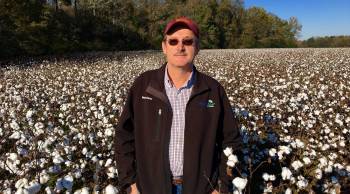Making cotton ‘the fabric of our lives’
TEXT OF STORY
Kai Ryssdal: Pork bellies were basically flat on the Chicago Mercantile Exchange today — $1.04 a pound, but that’s not the important part. What matters is what you think of when you think of pork. Unless I miss my guess, it’s probably “pork, the other white meat,” one of the better commodity branding campaigns you’re likely to run across.
But way before the other white meat, there was cotton. Cotton Incorporated, the industry group that gave us “the fabric of our lives” turns 40 this year.
Marketplace’s Jennifer Collins reports Cotton Inc. showed other commodity producers that image really does count.
Jennifer Collins: Back in the 70s, cotton had a problem.
Commercial: The wonderful world of wash and wear.
Synthetic fibers were moving in on cotton’s territory. They were easy to care for, and cotton needed to be starched and ironed. Plus, polyester had this guy making it look good.
James Brown singing: Get up, get on up. Get up, get on up.
Cotton needed to fight back. So a group of growers and importers created Cotton Incorporated. The organization took a tiny cut of every bale of the fiber bought or sold in the U.S. It hired a team of ad execs. And it launched a PR assault at a time when branding a commodity was virtually unheard of.
Mike Stevens trades cotton futures.
Mike Stevens: There were people, I can recall, people back in the early 70s were very very skeptical of paying this organization to do something.
…But they came around. As part of the multi-million dollar campaign, Cotton Inc. created a logo, it sponsored the ’76 Olympics and enlisted celebrities like Barbara Walters to build its image. Here she is talking up her Hawaiian shirt.
Barbara Walters in a commercial: Cotton. Right now, I’m sure it’s doing a lot to make your life comfortable. I know it’s making my life comfortable today. I’m wearing cotton.
Cotton Inc. also poured money into research to create fabrics that didn’t wrinkle or burn easily. And take this, James Brown:
Leona Lewis singing in a commercial: The touch the feel of cotton. The fabric of my life.
Forty years ago, cotton had about a third of the market. Now, it commands about two-thirds. Some of the growth, of course, is thanks to demand from growing economies like China and India. But eight out of 10 Americans can identify the cotton logo. And Cotton Inc. has set the standard for other commodities, like milk and raisins — as in “Got Milk?” and the California Raisins.
California Raisins commercial: Oooh, I heard it through the grapevine.
But catchy music and pretty celebrities only go so far. Branding expert Rob Frankel says simply calling cotton “the fabric of our lives” doesn’t make it so. He says Cotton Inc.’s ads need to make a stronger case for why people should it over other fabrics.
Rob Frankel: Nobody really has an idea what cotton is and why they should prefer it to anything else, in the way that they understand that milk is something that you drink to get calcium. They don’t know why you should wear cotton.
Jonathan Sample knows why. He runs a T-shirt printing business in Los Angeles. He also lets customers come in and print their own shirts at his shop Fresh Pressed.
Jonathan Sample: And you pick the screen up and there it is.
An ordinary piece of fabric with a giant splash of hot pink. He says that’s the kind of boost that Cotton Inc. gave to cotton.
Sample: Throwing that logo out there, out there, out there made us respect it, I would say, made us value it more.
We may soon find out how much more. Cotton prices have soared recently, and clothing makers are warning they’ll need to raise prices on T-shirts and jeans. That could pit cotton, once again, against synthetics in the battle to be the fabric of your… No, I’m not going to say it again.
I’m Jennifer Collins for Marketplace.
There’s a lot happening in the world. Through it all, Marketplace is here for you.
You rely on Marketplace to break down the world’s events and tell you how it affects you in a fact-based, approachable way. We rely on your financial support to keep making that possible.
Your donation today powers the independent journalism that you rely on. For just $5/month, you can help sustain Marketplace so we can keep reporting on the things that matter to you.


















